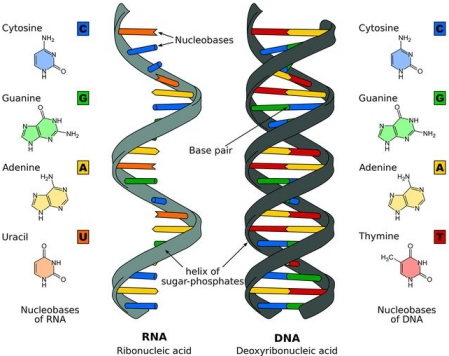MicroRNA Research Impacts Mesothelioma Claims
By Kathy Cooke. 3rd October 2018
RNA is a copy, or a transcription, of DNA. The DNA is very important as it holds the information needed for making new
cells and maintaining life, so it never leaves the nucleus. The RNA is the one that goes out to do work throughout the cell.
Without RNA our bodies would not be able to make proteins, which make up about 20% of our bodies.

Scientists in Italy say it may be possible to determine if a case of mesothelioma cancer was caused by exposure to asbestos by examining tiny cell structures known as MicroRNAs.
MicroRNAs are small molecules of RNA that play a key role in the regulation of gene expression in cells.
If the MicroRNA asbestos profile can be verified, it could have a significant impact on compensation for mesothelioma cancer and other asbestos related cancers.
Does Mesothelioma have a Molecular Fingerprint
Cancers including mesothelioma may the result of these MicroRNAs being out of balance. The scientists in Italy have been examining MicroRNAs of mesothelioma patients, lung cancer patients, and healthy subjects.
They are working to develop a MicroRNA signature profile unique to people were exposed to asbestos and have developed lung cancers as a result of that exposure.
If there is a consistency of the 'out-of-balance' MicroRNAs, they could be used to help identify asbestos-related cancer and mesothelioma.
MicroRNAs are involved in the development of Mesothelioma
As part of this research, the Italian scientists had 4 groups of test subjects
- one with pleural mesothelioma
- one with asbestos-related lung cancer
- one with non-asbestos related lung cancer
- one group of healthy subjects
The Scientists identified the signature of asbestos-related cancerous changes at the molecular level in mesothelioma
patients and patients with asbestos-related lung cancer.
4 MicroRNAs were found to be implicated in asbestos-related malignant diseases. Biochemist Dr Tomasetti writes:
“ Notably, increased expression of miR-126 and miR-222 were found in asbestos-exposed subjects, and both miRNAs are involved in major pathways linked to cancer development. ”
Impact on Mesothelioma Patient's Fight for Compensation
The study is potentially important for mesothelioma patients and their families for several reasons:
1. By identifying the molecular mechanisms behind the development of mesothelioma, the study opens the door to new mesothelioma treatments that directly target these mechanisms. Previous studies have suggested that focusing on MicroRNAs has the potential to improve mesothelioma immunotherapy.
2 . Signature MicroRNA profiles could be used to screen people who were exposed to asbestos to identify those at highest risk for developing cancer and may make it easier to diagnose cases of pleural mesothelioma earlier.
3. Asbestos-related MicroRNA profile could potentially be used in legal cases to provide further evidence that asbestos was the likely cause of a particular case of malignant mesothelioma or non-small cell lung cancer.
Any research that shows promise in an earlier diagnosis of mesothelioma and asbestos-related lung cancer is always welcome. This means that more treatment options will be available including surgery.

Source:
1. EMM. Jan, 2017. MicroRNAs in cancer metabolism: possible implications in cancer diagnostics and therapy
https://www.nature.com/articles/emm2016153
Author
Kathy Cooke MA. BSc
Cancer consultant and advisor
Kathy has worked in the cancer field for over 30 years. She was course leader for the MSc in Radiotherapy and Oncology at University of Hertfordshire. Then pre-treatment radiotherapy manager at the Cromwell Hospital in London and Partnership Quality Lead for Macmillan Cancer Support.. Read more >













